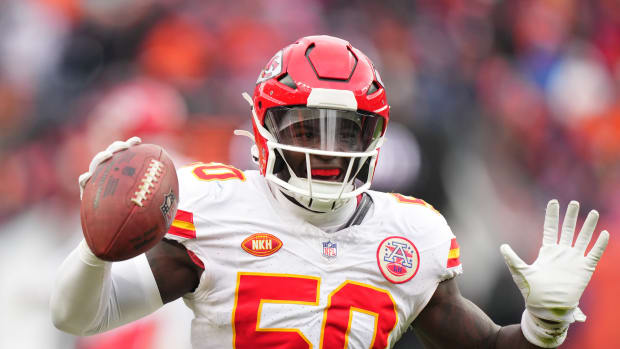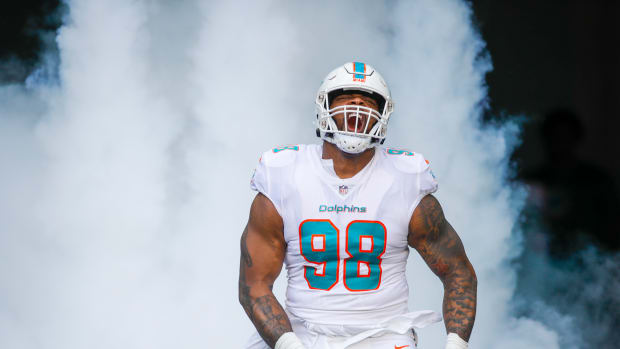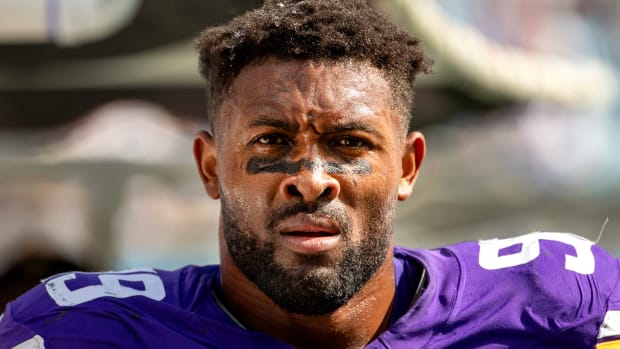Nick Saban’s NFL Past . . . and Future?
It didn’t matter that it was 95 degrees with high humidity. Or that the players just went through 45 minutes of on-field pre-practice work. Or that it was the middle of training camp. Or that it was the start of a three-hour practice for the 80 guys who were lining up for stretch. Every strap on every Dolphin’s helmet was going to be buckled.
“If you had one unbuckled,” says Sage Rosenfels, then a back-up quarterback for the Dolphins, “then someone was going to say something to you.”
“Nothing was ever good enough,” adds defensive lineman Kevin Carter. “He wasn’t selling us on making it happen on gameday. It was every day, in practice, day-in and day-out.”
That, in a nutshell, is what people remember about Nick Saban’s two-year run as an NFL head coach—the stories of his unrelenting nature, unbending attention to detail and uncompassionate handling of players. They remember him stepping over an injured player to get to a drill, and they remember him bolting for Alabama after saying he wouldn’t, and they see him as a college coach unfit for the pros. What they don’t remember? That, for a short time, it worked.
“It does work,” Carter says. “It made us tough. We had a sense of what excellence was. It wasn’t phony.”
In short order, Saban took a listless 4-12 team that endured a midseason coaching change in 2004, flipped the roster, battled past a 3-7 start, and finished 2005 on a six-game winning streak with Gus Frerotte as his quarterback. It was enough to make the 9-7 Dolphins a trendy pick to go to the Super Bowl the next year. And then Miami signed Daunte Culpepper instead of Drew Brees, and the rest is history.
Here’s the point: If you’re an NFL team hiring in six weeks, you should call Saban. Seriously. And you should make him say no to you, because, short of Bill Belichick suddenly springing available, or Sean Payton’s season in New Orleans going South, there won’t be anyone as qualified to lead your program than the Crimson Tide icon.
He might say no; few people who know him that I’ve spoken to believe he has any appetite for leaving Alabama. He might not be a 10-year answer for your franchise, since he’ll turn 67 during the 2018 season. He’s not 100% the answer to fix a failing team, because no new coaching hire is that. But he’s sure better than a lot of what we’ve seen out there during the 2017 season. In fact, if you had to pick the Top 5 football coaches on the planet, at any level, you’d be pretty hard-pressed to leave him off the list.
More than that, he’s exactly what a lot of NFL franchises need. Saban is a program builder of the highest order in an era where coordinators and quarterback gurus are getting moved into the corner office at a breakneck rate, only to prove incapable of running an organization or leading large groups, which are skills more vital to the job than any play design or any fixed throwing motion.
The results are indisputable. Saban won four national championships, five SEC titles and seven division titles in his first 10 years in Tuscaloosa, and he’s playing to add to all those figures over the next few weeks. He’s 130-19 over that time, and 123-13 if you eliminate his first year. He developed a total of 21 first round picks in the last seven drafts and two Heisman winners. And prior to that, he had Michigan State stalking the neighborhood of the Big Ten’s bluebloods, before changing LSU forever and winning a national title there.
There’s the one strike against him: how his time in Miami ended. It was ugly, there’s no getting around that. The Dolphins went into 2006 believing they were ready to contend, with the plan to acquire a veteran quarterback who was available because of injury. They picked the wrong one. Culpepper was on IR by early October. Miami started 1-6, and so even a 5-1 surge couldn’t save a lost year.
“He didn’t lose us on defense, because we were all old enough to understand, and disciplined enough to do our jobs,” says Carter. “But on offense, guys couldn’t see where we were going to turn the corner. To me, those are things that stuck out. If you’re an older player, you understand the discipline that winning demands. We had those players on defense . . . That was not there on offense.
“And if you’re going to govern a team like [Saban does], you have to make sure you have guys that buy in.”
Saban might not have had enough of them, but according to Carter and Rosenfels, he was building toward that, around like-minded stars Jason Taylor and Zach Thomas, and by acquiring tone-setting vets like Keith Traylor, Donnie Spragan, Vonnie Holliday and Carter himself.
As Carter explains it: “I’m not hurt, I’m not late, I’m going to do my workouts, I’m not out drinking, I’m unselfish, I’m a family man. That’s what he wanted.”
“I’m a Midwestern kid, a small-town kid, I grew up going to wrestling camp and working on a farm,” says Rosenfels. “The way I was brought up, you don’t have to like your coaches, you just do your job. I was used to that. But other guys had been in programs where the coach was player-friendly, and they were uncomfortable with one person running the whole thing.”
But the truth is, Saban’s time in Miami didn’t even really come down to that. Ahead of the 2006 offseason, he met with the leadership council he assembled—he called it his “peer group”—and asked them, according to Carter, if they’d rather have Brees or Culpepper. “In unison,” Carter recalls, “we said ‘Drew Brees.’”
Saban has since said that team doctors told him he couldn’t sign Brees, which has become a matter of dispute in South Florida. Carter speculates there were business interests in bringing Culpepper, a native Floridian, home. Whatever it was, the call to go get Culpepper, and let Brees go to New Orleans, leaves a lot to the imagination.
If the Dolphins get Brees? Maybe the nine-win season of 2005 is prelude to 11 or 12 wins in 2006. After all, Brees led a Saints team that won three games in in 2005 to 10 wins in 2006. And then, Saban could have pointed to the skins on the wall the way Bill Belichick does in New England when he is difficult with his players. It would have given Saban more time to settle in as an NFL head coach.
“I think they’d probably have had a 10-year run competing year-in and year-out with the Patriots,” Rosenfels says. “They still had a very good defense, and I thought he drafted fairly well, the free agents he brought in were good football players. I think he’d have been a very good NFL coach—and I bet he would’ve lightened up a little as he went on.”
“If he’d signed Brees, I think we’d have been in the playoffs consistently, and battling with the Patriots for the top of the AFC East,” Carter says. “If Brees came to Miami, he’s still the quarterback there, and you might have a championship team over that time.”
We’ll never know what could have been, but we do know what has been since, and it makes you wonder what could be if Saban decided to make one more run at filling that last line of a Hall of Fame résumé. Here’s hoping, at some point, we get to see him take a shot at it.
FIVE FROM SATURDAY
1. Twenty NFL teams were at the Sam Darnold/Josh Rosen showdown at the Coliseum on Saturday night. USC won the game 28-23, but you can make a pretty legit argument that it was the UCLA quarterback who won the beauty pageant. “They’re two different types of quarterbacks,” said one personnel exec who was in attendance. “One’s the pure pocket passer, and that’s Rosen, and Rosen won the duel between the two. Then, you got the improvisation, the Tony Romo type that Darnold is. Things break down, and he makes a play. And that’s what’s great about him, he can do it from pocket, [or] when things break down around him. And Rosen, when he gets time, it’s pretty. Both of them, I’d say, are going to be good players if they go into good situations . . . Get them with good coaches, they have a chance to be special.” For the record, Rosen wound up with 421 yards, three touchdowns and a pick on 32-of-52 passing, and Darnold had 264 yards and a pick on 17-of-28 passing.
2. The Baker Mayfield fiasco of last weekend is going to be scrutinized going forward, and so it’s worth addressing here (even if we address Mayfield every week). For better or worse, from an image standpoint, Mayfield’s become a real-life version of Charlie Tweeder, the receiver from Varsity Blues—free-wheeling both on the field and off it. Did Saturday’s antics affect his standing as a prospect? It depends who you ask. Some believe his success through all of this will validate that persona. Others see it as stuff he’ll grow out of, and point to how everyone in the Oklahoma program loves him as proof of his commitment to the sport and his team. So I’ll say again what I’ve said before, which is the one thing I’ve become certain of in doing this column the last three months: Mayfield will be the story of draft season.
3. Saturday’s Wisconsin win over Michigan was about as Wisconsin as it gets. The Badgers ran the ball 40 times, threw it 19 times, and worked the visiting Wolverines like a prizefighter. And like clockwork, the body blows eventually accumulated and the hosts were able to take over. They finished with 182 yards rushing, and outscored Michigan 17-3 in the second half despite up-and-down play from quarterback Alex Hornibrook. It’s a formula as enduring as Barry Alvarez’s presence in Madison, and in the recent past it’s added up to NFL linemen (Joe Thomas, Kevin Zeitler, Travis Frederick) and tailbacks (Melvin Gordon, James White, Corey Clement). This year’s crop? What’s interesting is they’re all underclassmen. Maybe left tackle Michael Deiter will go pro, but the rest of them are coming back, including true freshman workhorse back Jonathan Taylor.
4. It’s great watching Georgia’s Nick Chubb getting back to form, and setting himself up to be drafted somewhere on the Friday night of draft week. The senior, you’ll remember, was Todd Gurley’s sidekick/successor, and just as he was becoming the team’s bellcow in 2015 he tore his PCL. Since coming back, he’s been a little up and down, which explains why he returned for his final season in Athens. It’s paying off now. He showed tremendous burst and explosion in going for 151 yards on just 15 carries in the Bulldogs’ win over Kentucky.
5. Wherever Chip Kelly lands next—and it looks like it will be Florida or UCLA—it should be fun to see how the NFL experience will affect the way that he leads a college program. To be sure, he had his impact on the pros. And we detailed that in my Jan. 5 GamePlan column, from tempo to stretching the field vertically and horizontally to sports science, his fingerprints remain all over the NFL. But he also picked up new stuff, and so it should be cool to see more pro concepts in what he does. And it’s not like, at 44-5 in his four years in charge at Oregon, he wasn’t doing a good job there to begin with.






































